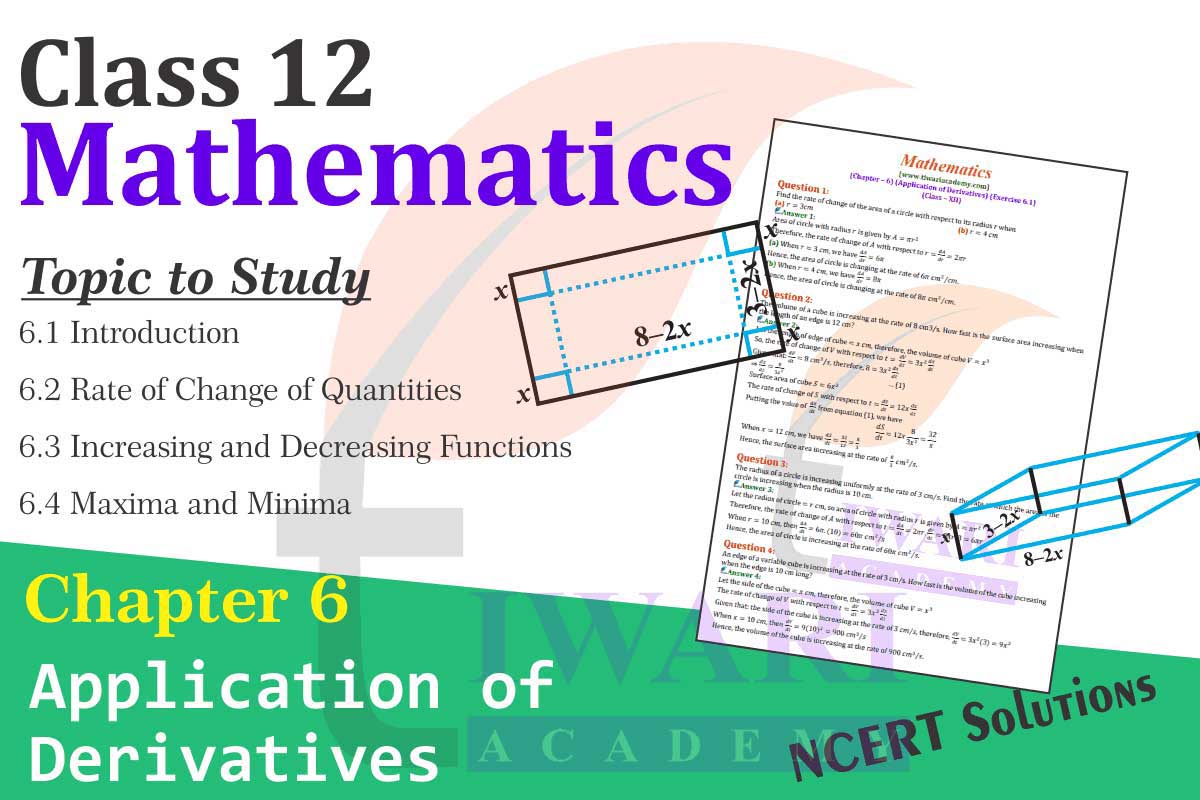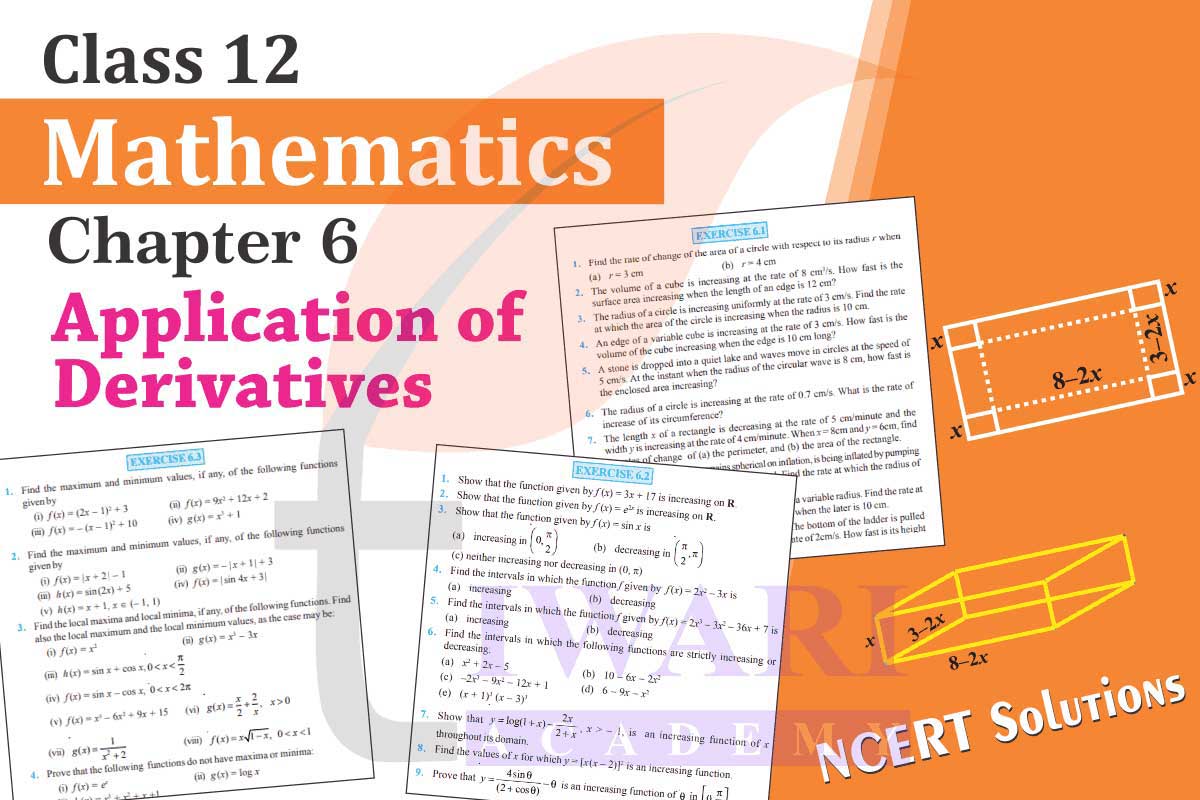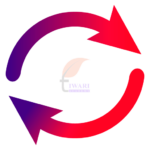NCERT Textbook Solutions for class 12 Mathematics Chapter 6 Applications of Derivatives in Hindi and English Medium for CBSE 2025-26 exams. As per the new syllabus for 12th Maths chapter 6, there are only four exercises (including miscellaneous) for new session 2025-26. NCERT Textbook Solutions for Class 12 Mathematics Chapter 6 Applications of Derivatives provide a step-by-step guide to mastering this essential math topic. NCERT Maths Textbook chapter 6 introduces important concepts such as increasing and decreasing functions, tangents, normals and maxima-minima.
NCERT Detailed Solutions Class 12 Maths Chapter 6 Applications of Derivatives
By referring to these NCERT Maths Textbook Class 12 Chapter 6 solutions, students can learn the mathematical process of solving problems related to real-life applications, such as finding the rate of change or optimizing functions. NCERT Class 12th Maths Chapter 6 exercise solutions are curated to simplify these concepts with solved examples and detailed explanations. Whether you are solving for miscellaneous exercises or specific important questions, these mathematics solutions are a reliable resource. For students seeking assistance in Hindi or English, the Applications of Derivatives Class 12 NCERT math solutions are available in PDF format for easy download.
Class 12 Maths Chapter 6 Solutions in English Medium
Step-by-Step NCERT Textbook Solutions for Class 12 Maths Chapter 6 Exercises
NCERT Textbook solutions for Class 12 Maths Chapter 6 exercises include a detailed breakdown of problems involving tangents and normals, helping students understand how to compute slopes of curves at given points. The Applications of Derivatives NCERT simple solutions PDF also focus on identifying turning points and studying their impact on the behavior of functions.
To enhance learning, students can use Class 12 Maths Textbook Chapter 6 NCERT Complete solutions by experts who provide clear and concise explanations. These solutions are designed to build a solid foundation for competitive exams by solving important questions step by step. Students preparing for board exams can benefit from these solutions as they align with the syllabus. NCERT PDF solutions for Class 12 Math Book Chapter 6 solved examples are helpful for understanding real-world applications like optimization and cost minimization.
Class 12 Maths Chapter 6 Solutions in Hindi Medium
Detailed Download of Applications of Derivatives Class 12 NCERT Book Solutions
For Board preparation, students can access Applications of Derivatives Class 12 NCERT mathematics solutions online and download. NCERT Textbook solutions for Class 12 Maths Chapter 6 PDF download offers systematic solutions to every problem, including miscellaneous exercises, with step-by-step mathematical explanations and derivations. NCERT Mathematics solutions focus on important calculus-based concepts such as derivatives, their applications in analyzing the behavior of functions and solving optimization problems. NCERT Class 12th Math solutions also include video lectures to provide a deeper mathematical insight into solving challenging problems related to increasing and decreasing functions and curve sketching.
Students can rely on the Class 12 Maths Chapter 6 NCERT solutions free download to practice and master key calculus concepts at their own pace. From detailed solved examples to critical important questions, this resource ensures learners develop confidence in applying mathematical techniques in their exams. Available in both English and Hindi, these NCERT textbook solutions use a clear and logical mathematical approach, making the study of Applications of Derivatives both engaging and practical for students.
| Class: 12 | Mathematics |
| Chapter 6: | Applications of Derivatives |
| Content: | Textbook Exercises Solution |
| Content Type: | Text, PDF and Videos |
| Session: | CBSE 2025-26 |
| Medium: | Dual Medium – Hindi, English |

Important Points in Class 12 Maths Chapter 6 Applications of Derivatives for Exams
Key points in Applications of Derivatives include understanding increasing and decreasing functions, solving tangents and normals, finding maxima and minima and analyzing the rate of change of quantities. Focus on Class 12 Maths Chapter 6 important questions, solved examples and miscellaneous exercises for thorough exam preparation.
| Day | Topic | Task | Resources |
|---|---|---|---|
| Day 1 | Introduction to Applications of Derivatives | Understand concepts like tangent, normal and rate of change. | NCERT textbook, online video lectures |
| Day 2 | Increasing and Decreasing Functions | Solve basic examples and Class 12 Maths Chapter 6 exercise solutions. | NCERT solutions PDF, solved examples |
| Day 3 | Maxima and Minima | Practice problems on local maxima and minima using graphs. | NCERT miscellaneous exercises, important questions |
| Day 4 | Applications in Real-Life Problems | Study optimization problems and solve advanced examples. | NCERT solutions for Class 12 Maths Chapter 6 |
| Day 5 | Miscellaneous Exercises | Revise and attempt all miscellaneous exercises and sample papers. | NCERT textbook, previous year papers |
| Day 6 | Full Chapter Revision | Review all topics, solve important questions, and clear doubts. | Online solutions, video lectures, notes |
NCERT solutions for class 12 Maths chapter 6
Class XII Maths Chapter 6 exercise 6.3, 6.2, 6.1 (rate of change, increasing decreasing, and maxima minima) in PDF format for new academic session 2025-26. 12th NCERT solutions for math subject are modified according to CBSE exams. UP Board Intermediate students can take help from these solutions. Grade 12th Math chapter 6 solutions are given here in Hindi and English Medium with Videos explanation.
Class 12 Maths Chapter 6 Study Material
- Class 12 Maths NCERT Book Chapter 6
- Class 12 Maths Revision Book Chapter 6
- Class 12 Maths Revision Book Answers
- Download Class 12 Maths Chapter 6 Assignment 1
- Download Class 12 Maths Chapter 6 Assignment 2
- Download Class 12 Maths Chapter 6 Assignment 2 Answers
- Download Class 12 Maths Chapter 6 Assignment 3
- Download Class 12 Maths Chapter 6 Assignment 4
- Class 12 Maths NCERT Solutions
- Class 12 all Subject NCERT Solutions
Previous Years CBSE Questions
- The sides of an equilateral triangle are increasing at the rate of 2 cm/sec. Find the rate at which its area increases, when side is 10 cm long. [CBSE Sample Paper 2017]
- The volume of a sphere is increasing at the rate of 3 cubic centimeter per second. Find the rate of increase of its surface area, when the radius is 2 cm. [Delhi 2017]
- The side of an equilateral triangle is increasing at the rate of 2 cm/s. At what rate is its area increasing when the side of the triangle is 20 cm? [Delhi 2015]
- Determine for what values of x, the function f(x) = x³ + 1/x³, where x ≠ 0, is strictly increasing or strictly decreasing. [CBSE Sample Paper 2017]
- Show that the function f(x) = 4x³ – 18x² + 27x – 7 is always increasing on R. [Delhi 2017]
- Find the interval in which f(x) = sin 3x – cos 3x, 0 < x < π, is strictly increasing or strictly decreasing. [Delhi 2016]
- Find the point on the curve y = x³ – 11x + 5 at which the tangent is y = x – 11. [CBSE Sample Paper 2017]

Questions from Board Papers
1. Find the equation of tangents to the curve y = cos(x + y), where x lies in [- 2π, 2π], that are parallel to the line x + 2y = 0. [Foreign 2016]
2. Find the shortest distance between the line x – y + 1 = 0 and the curve y² = x. [CBSE Sample Paper 2017]
3. If the sum of lengths of the hypotenuse and a side of a right angled triangle is given, show that the area of the triangle is maximum, when the angle between them is π/3. [Delhi 2017]
4. Show that the altitude of the right circular cone of maximum volume that can be inscribed in a sphere of radius r is 4r/3. Also find maximum volume in terms of volume of the sphere. [Delhi 2016]
5. The sum of the surface areas of a cuboid with sides x, 2x and x/3 and a sphere is given to be constant. Prove that the sum of their volumes is minimum, if x is equal to three times the radius of the sphere. Also find the minimum value of the sum of their volumes. [Foreign 2016]
6. A tank with rectangular base and rectangular sides open at the top is to be constructed so that its depth is 3 m and volume is 75 cubic meter. If building of tank costs ₹ 100 per square metre for the base and ₹ 50 per square meters for the sides, find the cost of least expensive tank. [Delhi 2015C]
7. A point on the hypotenuse of a right triangle is at distances ‘a’ and ‘b’ from the sides of the triangle. Show that the minimum length of the hypotenuse is (a²/³ + b²/³)³/². [Delhi 2015C]
8. Find the local maxima and local minima, of the function f(x) = sin x – cos x, 0 < x < 2π. Also find the local maximum and local minimum values. [Delhi 2015]
What topics are covered in NCERT Solutions for Class 12 Maths Chapter 6 Applications of Derivatives?
NCERT textbook solutions for Class 12 Mathematics Chapter 6 Applications of Derivatives cover key topics such as increasing and decreasing functions, tangents and normals, maxima and minima and the rate of change of quantities. These concepts are crucial for solving real-life mathematical problems like optimization, cost minimization and understanding curves’ behavior. The solutions also provide step-by-step explanations for Class 12th NCERT Math Chapter 6 exercise solutions, CBSE solved examples and NCERT miscellaneous exercises. By using these resources, students can build a solid understanding of derivatives’ applications and prepare for exams effectively. These solutions are available in English and Hindi for easy learning.
How interesting the chapter 6 Class 12th Maths is?
Yes, applications of derivatives (chapter 6 grade 12th Maths) is an interesting chapter. Some real-life applications of derivatives (chapter 6 grade 12th Maths) are:
- To find the profit and loss in business using graphs.
- To check the variations in temperature.
- To determine the speed and distance, such as miles per hour, kilometer per hour, etc.
- Derivatives are used in physics to derive many equations.
- In the study of Seismology, like, to find the range of magnitudes of the earthquake.
- Also, students can study applications of the derivatives in various fields like engineering, science, social science, etc.
- Students can use derivatives in economics also.
- In daily life, the derivative can help you predict fluctuations in the stock market.
- Derivatives are important for function optimization in machine learning.
How can NCERT Solutions for Class 12 Maths Chapter 6 help in exam preparation?
The Applications of Derivatives Class 12 NCERT mathematics solutions are specifically designed to help students excel in board and competitive exams. These solutions provide a detailed and easy-to-understand approach for solving important questions and analyzing the behavior of functions through tangents, normals and turning points. With step-by-step explanations for every problem, NCERT book solutions for Class 12 Maths Chapter 6 exercises build confidence and clarity. Students can also download the NCERT solutions for Class 12 Mathematics Chapter 6 PDF to practice offline. The focus on miscellaneous exercises ensures thorough preparation for complex problems.
What is the basic motive of chapter 6 of 12th Maths NCERT?
The basic motive of chapter 6 of grade 12th Maths is to make the following things clear to the students:
- 1. Rate of change of quantities.
- 2. Increasing and Decreasing functions.
- 3. Maxima and Minima.
Where can I find Applications of Derivatives Class 12 NCERT solutions in PDF?
Students can easily access Applications of Derivatives Class 12 NCERT Textbook solutions online and download the PDF version for free. These resources include step-by-step solutions for all exercises, including important questions and miscellaneous exercises, ensuring comprehensive preparation. NCERT Book solutions for Class 12 Maths Chapter 6 PDF download is available in both English and Hindi, making it accessible to students across different regions. These solutions are supplemented with video lectures and expert explanations to simplify complex topics like maxima-minima and the rate of change. Downloading the PDF allows students to revise concepts at their convenience.
Which exercise of chapter 6 of 12th Class Maths has the highest number of problems?
Chapter 6 of grade 12th Maths has 6 exercises.
In the first exercise (Ex 6.1), there are 24 problems (6 examples and 18 questions).
In the second exercise (Ex 6.2), there are 26 problems (7 examples and 19 questions).
There are 40 problems (15 examples and 25 questions) in the third exercise (Ex 6.3).
In the last (Miscellaneous) exercise, there are 34 problems (10 examples and 24 questions).
So, the fifth exercise (Ex 6.3) has the highest number of problems.
Is there any chapter that students should revise before starting chapter 6 Class 12th standard Maths?
Before starting chapter 6 (Applications of Derivatives) of 12th standard Maths, students should revise chapter 5 (Continuity and Differentiability) of grade 12th Maths. Chapter 5 of class 12th Maths works as a base for chapter 6 of class 12th Maths.
Does chapter 6 of grade 12th Maths has any miscellaneous exercise?
Yes, chapter 6 of grade 12th Maths has a miscellaneous exercise. There are 6 exercises in chapter 6 of class 12th Maths, and the last exercise is the miscellaneous exercise of chapter 6 of grade 12th Maths.


